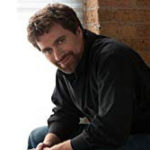I get a lot of compliments for my battle scenes. Which is lovely, as they’re some of the most fun and challenging for me to write.
I come from the theatre, and among the hats I wear in my professional life is Fight Director. I’m trained in different styles of swordplay, and I’ve traveled all over the world to learn from the best in the field. So when it comes time to write an skirmish, a duel, or a battle, I find myself standing in my office, sword in hand, working the movements one after another. I pick up a spear. Then an axe. I actually own a halberd, a gift from a cast of a Richard III I once directed, and that came into play up on my roof. I always find myself choreographing the fights as I would for a stage show, but on a much larger canvas.
The art of stage combat is looking incredibly violent while being incredibly safe. I try to bring some of that to my novels, varying the type of fighting, the kind of weapons, the intent of the combatants. Sometimes the fighting is light-hearted, sometimes desperate and sudden. But there’s a secret to making a good fight on stage, and I’ve found it works perfectly well in my writing as well.
But first, the technical elements. The page allows me to do two things. First, I can broaden the scope of the fighting, doing a great deal on horseback, which I have only had one abortive attempt at in theatre (seriously, don’t ask). Second, I can slow the action down. Part of the trouble in stage violence is that if it goes by too quickly the audience isn’t sure what happened. If it happens too slow, they don’t believe it. A very tricky balance to maintain. Pacing is as important in a novel as it is onstage, but the written word does afford me a little more latitude.
In fact, one big influence in how I “stage” my written fight scenes is, of all people, Tom Clancy. The pacing in his early novels is fantastic. I love the way he intercuts scenes, building tension and rhythm for Jack Ryan’s adventures, cutting away at the most dramatic moments. Having stolen this technique, I’m told it makes my novels cinematic, which I choose to take as a compliment.
Something else I’ve noticed I do is wound my characters far more than I ever intend at the outset. In the Star-Cross’d series, Pietro was never meant to be crippled by a blow to the leg so early. It just happened, and I have to admit it’s made all his subsequent fighting much more interesting. I’ve always been a fan of the James Bond and Sharpe books where the hero has to spend a month in the hospital after saving the day. Violence has to have stakes. We can’t just create a red shirt to kill him off. People we care about have to die, or at least be hurt, to make us feel the importance. There have to be consequences.
The hardest part for me is balancing what I need to know to write a fight with what the reader needs to read it – which is often much less. I write out the whole of the physical fight scene, then begin paring away excess detail, revealing the core.
Which brings us to the secret of a good fight scene.
One thing I’ve learned in theatre is that a good fight is not about cool moves. It’s not about blood, or violence. It’s about story. The fight itself has to tell a story. A fight is like any conflict – it’s a tale of desire and denial.
Desire: I want your life.
Denial: You can’t have it.
It’s almost romantic, and combatants have just as much intimacy as lovers. One funny story is that a rather famous theatre with rather famous actors had to hire a Fight Director friend of mine, not for a fight scene, but for a love scene. The actors just couldn’t stage the lovemaking right – kept stepping on toes and banging teeth. So they hired a Fight Director to stage the lovemaking.
Likewise, I’ve found that writing a love scene is very much like writing a duel – everyone has a motive, everyone has a goal. The writer cannot be too graphic without losing the audience, but too vague and it becomes a wash.
Sex and violence – two sides of the same coin. Both are all about desire.


What a brilliant article. I enjoyed your idea of tension and wounds and most important was that violence costs. Nice hats off to Mr. Cornwell. A fight Director staging love scenes simply makes perfect sense to me. I’ll bet the love scenes were awesome. 🙂
You know they were! Hey everybody – meet the fellow I’m honored to call my friend, Mr. Rick Sordelet, Fight Director to the stars, and a brilliant writer in his own right. Rick and I have had the pleasure of working together theatrically, what, four times now? So when he talks about stage violence, listen close. Thanks, Rick!!